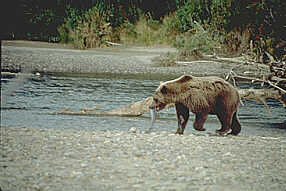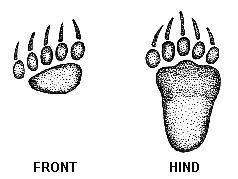
Grizzly Bear
Ursus arctos
Description
- Grizzly Bears reach weights of 300-1500 pounds.
The coat color ranges from shades of blond, brown, black
or a combination of these; the long outer guard hairs
are often tipped with white or silver giving it a grizzled
appearance hence the name. The grizzly has a large hump
over the shoulders which is a muscle mass used to power
the forelimbs in digging. The head is large and round
with a concave facial profile. In spite of their mass
size this bear runs at speeds of up to 35 mph.
Distribution
- Once native to Asia, Africa, Europe and North America,
it is now in some areas extinct or had its numbers greatly
reduced. In BC Grizzly Bears inhabit most of the province
except Vancouver Island, the Queen Charlotte Islands
and the lower mainland. Nearly half of Canada's grizzly
population - about 13 000 - lives in this province.
They prefer semi-open country usually in mountainous
areas.
Biology
- The Grizzly Bear is primarily nocturnal and in the
winter puts on up to 400 pounds of fat, becoming very
lethargic. Although they are not true hibernators and
can be woken easily, they like to den up in a protected
spot, such as a cave, crevice or hollow log during the
winter months. Being omnivores, they feed on a variety
of plants and berries including roots or sprouts and
fungi as well as fish, insects and small mammals. Normally
a solitary animal, the grizzly congregates alongside
streams and rivers during the salmon spawn. Every other
year females produce 1-4 young which are the size of
rats, weighing only 1 pound.

Tracks - The prints of the grizzly bear are characterized
by an oval pad with five toes along the wider top of
the pad on the hind feet. The front feet have a smaller
heel pad and a dew claw which may be present in the
print. Claw marks over twice as long as the toe pads
are usually evident.
Straddle: 32 - 38 cm (12.8 - 15.2 in)
Stride: 30 - 45 cm (12 - 18 in)
Track:


